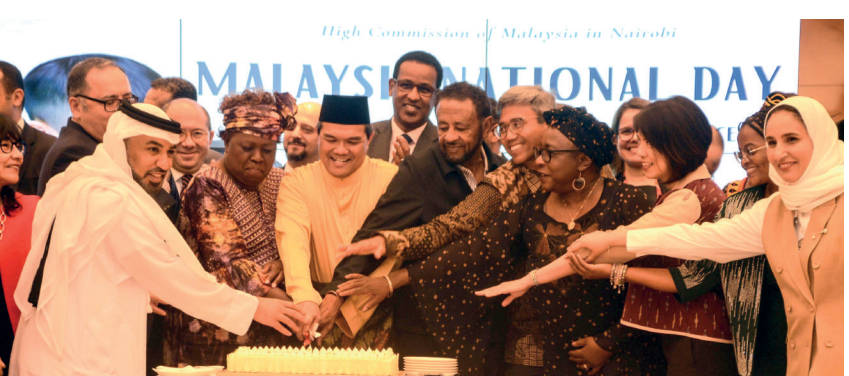
In the
1960s, Kenya and Malaysia were both newly independent nations with comparable economic
structures. Both economies were largely agrarian and relied on the export of primary
commodities. Interestingly, in 1968, Kenya gave a $5 million grant to Malaysia,
reflecting a perception of equality—or even relative Kenyan advantage—at that
time.
However, by
2023, Malaysia had developed into a diversified, semi-industrialised economy with
a significantly higher GDP, per capita income, and development index, while
Kenya's growth has remained modest.
In 1965,
Kenya’s GDP was approximately $0.63 billion, while Malaysia’s was around $2.4 billion.
By 2023, Kenya’s GDP had grown to $108 billion, whereas Malaysia’s reached $399
billion. GDP per capita presents a starker contrast: Kenya grew from $100 in
1965 to $1,950 in 2023. Malaysia, by comparison, grew from $316 to $11,650.
These figures highlight Malaysia’s rapid industrial growth and diversification,
compared to Kenya’s continued dependence on low-value agriculture and services.
During the
1970s and early 1980s, Kenya experienced relatively strong growth, averaging around
6–7 per cent annually. However, this growth slowed in subsequent decades due to
poor governance and political instability.
Malaysia, on the other hand, maintained growth through consistent
economic planning, including its New Economic Policy and later Vision 2020.
Early this
month, I had the opportunity to visit Malaysia and from the time I landed at
the airport, one question that kept bothering me was why the divergent economic
trajectories between the two countries.
Malaysia has
been successful in attracting foreign direct investment, particularly into its
manufacturing, electronics, and energy sectors. As of 2023, Malaysia had an FDI
inflow of $8.6 billion compared to Kenya’s $1.6 billion. Malaysia's supportive
infrastructure, business-friendly policies, and political stability made it an
attractive destination for investors.
Industrialisation played a major role in Malaysia’s growth. The industrial sector contributed 38 per cent to Malaysia’s GDP in 2023, compared to just 16 per cent for Kenya. Malaysia capitalised on its export zones and technology parks to foster growth in electronics, automotives, and petrochemicals.
Kenya’s manufacturing sector,
despite being prioritised in policy (like Vision 2030), has not grown
significantly, due to constraints such as unreliable power, corruption, weak
infrastructure and policy inconsistency. I kept hoping that before the end of
our short visit I would get a convincing answer to my concern of the glaring
differences.
An arranged
meeting with a private consulting company PEMANDU associates who served as Malaysia’s
delivery unit under the Prime Minister’s Department from 2010 to 2017 gave me
an insight and an answer to some of my concerns. Spearheading the National
Transformation Programme, PEMANDU chairman Idris Jala served as a cabinet minister
during this period, having been poached from the private sector.
Jala made a
compelling presentation on how they successfully used what he terms as Big Fast Results and the eight-step methodology framework for the National
Transformational Programme. The prime minister and cabinet ministers placed the
transformational programme as their number one priority.
The first
step was to hold strategic leadership workshops, where leaders obtained clarity on the True North, defined the measurements of success, and aligned key priorities across the government. Step two involved leaders collaborating with their teams and
developing a detailed implementation plan. This involved breaking down high-level
plans to the lowest level of details. To achieve this objective, there was the
establishment of what Jala called labs. Teams with similar deliverables are
locked up in a hotel to come up with workable solutions and are only allowed to
leave upon arriving and all agreeing at
workable solutions.
Some labs
could take up to eight weeks. The lab was therefore used as a tool to break
siloes and force people to work together. The third step involved holding open
days (townhalls) to inform the entire nation of the plan and secure their buy-in.
The fourth step involved publishing a roadmap to rally the entire nation to become
part of the high -performing team.
The fifth step is setting clear key performance indicators, which are cascaded to the entire government. Sixth is to pursue what Jala referred to as DMS implementation ( do it relentlessly, monitor consistently and solve problems recursively).
The
seventh step is ensuring external validation of results by an independent body
for the results to be credible and not fudged. The final step is to publish the
result annually so that the public is informed of the achievements and
shortfalls.
While the above strategy appears simple and nothing out of the ordinary, the results it delivered were impressive. From the start of implementation of the National Transformation Programme in 2010 to 2017 Malaysia achieved a year-on-year fiscal sustainability and record government revenues.
Private investments dramatically
increased during the period, from $101.3 billion in 2010 to $225.6 billion in
2017. Government investments grew but at a slower pace during the same period.
This implies that the growth was majorly driven by private sector investments
and therefore a pointer to investor confidence.
During this
period Malaysia was just a little shy of hitting the high-income status per
capita income, achieving $11,120 per capita against the World Bank measurement
of $12,735. This growth significantly impacted all sectors of the economy.
Infrastructure
provided inclusive rural development, energy and transportation to over 6.2
million people. On Social protection, over 7 million low-income households were
impacted and their economic status lifted. Millions of jobs were created across
all sectors of the economy.
Kenya has a lot
learn from the case of Malaysia and other emerging Asian Tigers such as
Singapore and South Korea, who have successfully transformed their economies
from underdeveloped to developed within a short period. To achieve the
development that we all as citizens of our republic dream of, all have a role
to play and it cannot be business as usual. We must be ready to do business unusual,
with the government leading. Kenya is perfectly positioned to leap into this future.
But only if we seize that opportunity. Big, fast results is what we must
embrace.













